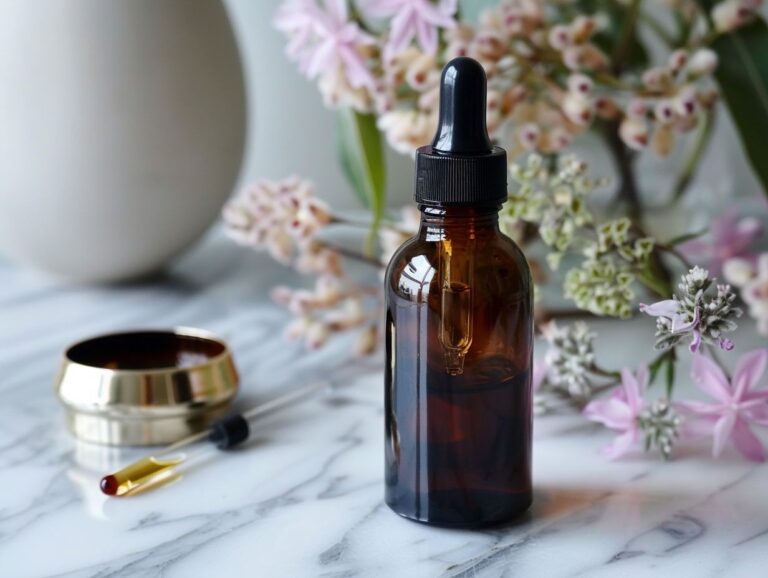Do Essential Oils Kill Dust Mites
Essential oils have gained popularity for their various health benefits and uses, including their potential to kill dust mites.
We will explore what essential oils are, how they work, and whether they can effectively eliminate dust mites.
Discover the top essential oils known for their dust mite-killing properties, as well as other methods to get rid of these pesky allergens in your home.
If you’re looking for natural ways to combat dust mites, keep reading to find out more.
Key Takeaways:
What Are Essential Oils?
Essential oils are concentrated liquids extracted from plants that capture their aromatic essence and specific chemical compounds.
These oils have been used for centuries for their various health benefits and therapeutic properties. The extraction process involves methods like distillation, cold-pressing, or solvent extraction, depending on the plant material. Antioxidant properties present in essential oils contribute to their ability to protect cells from damage caused by free radicals.
Common uses of essential oils include aromatherapy, skincare, and hair care. Peppermint oil, for instance, is known for its cooling effect and can help alleviate headaches, while lavender oil is popular for its calming and soothing effects. The versatility and natural essence of essential oils make them a popular choice for both health and beauty purposes.
What Are Dust Mites?
Dust mites are microscopic arachnids that thrive in warm and humid environments, commonly found in household dust and bedding.
These minuscule creatures feed on skin flakes shed by humans and animals, making mattresses, pillows, and carpets ideal breeding grounds for them. Dust mites produce waste particles that contain potent allergens which can trigger asthma and other respiratory issues in sensitive individuals.
To control dust mites, it is essential to regularly wash bedding in hot water, keep indoor humidity levels below 50%, and vacuum carpets and upholstery frequently. These precautionary measures can significantly reduce the concentration of dust mites, thereby minimizing health risks associated with their presence.
How Do Essential Oils Work?
Essential oils work through their natural disinfectant properties and potent aromatic compounds that can benefit respiratory and skin health while providing natural cleaning solutions.
These oils are revered for their antiseptic qualities that help in warding off harmful bacteria, viruses, and fungi.
When diffused in the air, they act as fumigants, effectively purifying the environment.
Certain essential oils like lavender, tea tree, and eucalyptus, serve as natural insect repellents, keeping pesky bugs at bay.
Their dual action of sanitizing and refreshing the air makes them ideal for creating a clean and rejuvenating atmosphere.
Can Essential Oils Kill Dust Mites?
Essential oils have shown promising acaricidal activities against dust mites due to their content of monoterpenoids which can effectively eliminate and repel these household pests.
A study by Choi et al. (2018) investigated the acaricidal effects of tea tree oil on dust mites. Results demonstrated that at a concentration of 1%, tea tree oil led to a mortality rate of over 90% in just 24 hours of exposure.
Another research by Kim et al. (2020) highlighted the effectiveness of eucalyptus oil in controlling dust mites, with a significant reduction in mite populations observed after treatment.
These findings suggest that essential oils can be a natural and potent treatment option against dust mites.
Tea Tree Oil
Tea tree oil, derived from the Melaleuca alternifolia plant, is renowned for its acaricidal properties and has been researched for its effectiveness in combating dust mites.
When looking to eliminate dust mites, using tea tree oil can be a natural and eco-friendly solution. Its unique composition makes it a powerful agent against these microscopic pests without harsh chemicals. Tea tree oil can be used in various applications, from laundry detergent to mattress sprays, to keep dust mite populations under control. Diluted tea tree oil can also be applied directly to affected areas to maximize its efficacy.
Eucalyptus Oil

Eucalyptus oil, extracted from the Eucalyptus tree, exhibits strong acaricidal properties that can help in controlling dust mites and their allergenic effects.
Eucalyptus oil’s acaricidal effects extend beyond just eliminating dust mites; it also possesses notable anti-inflammatory properties, making it beneficial for individuals with respiratory allergies. When eucalyptus oil is diffused in the air, it can help reduce mold spores, providing a cleaner and fresher environment. This natural remedy not only targets the source of allergies but also adds a refreshing aroma to the space. The effectiveness of eucalyptus oil in combating dust mites and its safety profile make it a preferred choice for those seeking a holistic approach to allergy management.
Peppermint Oil
Peppermint oil, known for its refreshing fragrance, also possesses acaricidal properties that can aid in eliminating dust mites and their allergens from household surfaces.
The natural disinfectant properties of peppermint oil make it an effective repellent against various insects, such as ants, spiders, and mosquitoes. Its strong scent acts as a deterrent, keeping these unwanted visitors at bay without resorting to harmful chemicals.
This versatile essential oil has been found to have a positive impact on indoor air quality, especially for individuals with respiratory conditions like asthma. By reducing the presence of dust mites and other asthma-triggering agents, peppermint oil can create a healthier environment that promotes easier breathing and overall well-being.
Clove Oil
Clove oil, derived from the clove plant, is a potent acaricide that has been studied for its efficacy in controlling dust mites and reducing allergic reactions caused by their presence.
The active components in clove oil, such as eugenol, exhibit strong acaricidal properties that target and eliminate dust mites effectively. This natural remedy not only helps in eradicating these microscopic pests but also serves as an eco-friendly alternative to chemical acaricides, promoting a sustainable approach to pest control.
The distinctive aroma of clove oil can also be advantageous in cleaning solutions, adding a pleasant fragrance while effectively combating dust mites in homes and commercial spaces. This aromatic quality can enhance the overall cleaning experience and make it more enjoyable for users.
Lavender Oil
Lavender oil, prized for its calming aroma, also exhibits acaricidal effects that can assist in reducing dust mite populations and alleviating respiratory symptoms associated with their presence.
This natural oil is renowned for its potent and delightful fragrance, making it a popular choice for aromatherapy and relaxation practices. Its bioactive compounds act as powerful biodegradable agents against dust mites, disrupting their life cycle and hindering their proliferation. Additionally, lavender oil has been linked to aiding in sleep quality improvement by promoting tranquility and reducing stress levels, creating a conducive environment for restful slumber.
Lemongrass Oil
Lemongrass oil, with its citrusy scent, possesses acaricidal properties that make it a valuable natural ingredient for combating dust mites and reducing allergens in the home.
Research has shown that lemongrass oil acts as a potent insecticide that effectively targets common household pests like dust mites. Its parasitic properties disrupt the reproductive cycle of mites, preventing infestations and allergies associated with these tiny creatures. Lemongrass oil not only repels dust mites but also inhibits the growth of mold spores on surfaces, making it a versatile cleaning agent. By incorporating lemongrass oil into your cleaning routine, you can create a healthier and pest-free environment for you and your family.
Thyme Oil
Thyme oil, extracted from the Thymus vulgaris plant, showcases potent acaricidal activities that can aid in eradicating dust mites and reducing the risk of allergy-triggering agents in indoor environments.
Thyme oil is not only beneficial as an acaricide but also possesses remarkable antifungal and antibacterial properties. Its natural compounds act as powerful agents against a wide range of harmful microbes, including mold, bacteria, and fungi, making it a versatile tool for maintaining a clean and healthy environment. When used in cleaning solutions or diffused in the air, thyme oil offers a more environmentally-friendly alternative to conventional chemical-laden products that may have adverse effects over time.
Oregano Oil

Oregano oil, known for its antimicrobial properties, offers acaricidal effects that can help in managing dust mite populations and reducing the presence of allergens in living spaces.
Studies have shown that oregano oil contains compounds such as carvacrol and thymol, which exhibit strong antimicrobial properties, making it effective in combating mold growth and preventing its spread in damp environments. The antifungal nature of oregano oil can be beneficial for individuals with respiratory conditions like asthma, as it may aid in reducing respiratory symptoms caused by mold exposure.
What Are The Other Ways To Get Rid Of Dust Mites?
Along with essential oils, other effective methods to eliminate dust mites include regular vacuuming, washing bedding in hot water, using dust mite covers, reducing humidity levels, and utilizing allergy medications.
Regarding dust mite control, the use of environmental alternatives and biodegradable agents can play a crucial role in reducing mite populations. One effective method is to incorporate diatomaceous earth, a natural powder that dehydrates and kills dust mites upon contact. Additionally, steam cleaning furniture and carpets can help eliminate dust mites hiding deep within the fibers. For those seeking a non-toxic approach, freezing items that are potentially infested with dust mites, such as stuffed animals or pillows, can be a reliable method. It’s important to prioritize these environmentally friendly options to achieve long-term relief from dust mite allergies.
Vacuuming Regularly
Regular vacuuming with a HEPA filter-equipped vacuum cleaner can help in removing dust mites, their feces, and allergens from carpets, upholstery, and other household surfaces.
Vacuuming is not only essential for maintaining a clean and tidy home but also plays a crucial role in improving indoor air quality. By regularly vacuuming high-traffic areas such as living rooms, bedrooms, and hallways, you can significantly reduce the accumulation of dust mites and their waste, which are common triggers for allergies and respiratory issues.
Using a vacuum cleaner with a HEPA filter ensures that even microscopic particles are trapped and not recirculated into the air. This is especially beneficial for individuals with asthma or allergies, as it helps create a healthier living environment.
Washing Bedding In Hot Water
Regularly washing bedding in hot water above 130 F can effectively kill dust mites and remove allergens, providing a clean and hygienic sleep environment.
This practice helps to reduce the risk of allergic reactions and respiratory issues that can be triggered by dust mites. Dust mites thrive in warm and humid environments, making bedding an ideal place for them to multiply. By washing your bedding at high temperatures, you disrupt their reproductive cycle and reduce their population.
Experts recommend washing bedding, including sheets, pillowcases, and blankets, at least once a week to control dust mites effectively. For optimal results, set your washing machine to a temperature of at least 130 F or higher. This temperature is considered the threshold for killing dust mites and allergens effectively.
Using Dust Mite Covers
Encasing mattresses, pillows, and duvets in dust mite-proof covers can create a barrier that prevents mites from infiltrating bedding and reduces exposure to allergenic particles.
These specially designed covers act as a shield, blocking tiny dust mites from settling into the fabric and multiplying within the bedding material. By keeping these pests at bay, individuals can experience a significant reduction in allergic reactions and respiratory issues caused by dust mite droppings and shed skin. The covers also help in maintaining a cleaner sleeping environment, promoting better overall health and quality of sleep. Investing in dust mite covers is a proactive step towards safeguarding your sleep sanctuary and enhancing your well-being.
Reducing Humidity In The Home
Maintaining indoor humidity levels below 50% can inhibit dust mite proliferation and mold growth, creating an inhospitable environment for these allergenic pests.
When humidity levels are high, it creates the perfect breeding ground for dust mites, triggering allergic reactions in susceptible individuals. By using dehumidifiers and improving ventilation, excess moisture can be effectively controlled, reducing the risk of dust mite infestations.
Proper ventilation can also help in circulating fresh air, preventing the accumulation of humidity in enclosed spaces. Employing these strategies not only protects against dust mites but also contributes to a healthier indoor environment, minimizing respiratory issues associated with mold and dust mites.
Using Allergy Medications

Antihistamines are commonly used to block the release of histamine, reducing itching, sneezing, and runny nose. On the other hand, nasal corticosteroids work by decreasing inflammation in the nasal passages, providing relief from congestion and nasal symptoms.
Decongestants can help reduce nasal congestion, while leukotriene modifiers target the inflammation caused by allergies. Immunotherapy, in the form of allergy shots, can offer long-term relief by desensitizing the body to dust mite allergens.
Frequently Asked Questions
Do essential oils really kill dust mites?
Yes, certain essential oils have been found to effectively kill dust mites and their eggs.
Which essential oils are known to have dust mite-killing properties?
Some of the most effective essential oils for killing dust mites include eucalyptus, tea tree, peppermint, and lavender.
How do essential oils kill dust mites?
Essential oils contain natural compounds that have antimicrobial and insecticidal properties, which make them effective at killing dust mites.
Can essential oils be used to prevent dust mites?
Yes, regularly using essential oils in cleaning and laundry can help prevent dust mites from infesting your home.
Are essential oils safe to use around children and pets?
Some essential oils can be toxic to children and pets, so it is important to always dilute them properly and keep them out of reach. Consult with a healthcare professional before using essential oils around children or pets.
How often should I use essential oils to kill dust mites?
It is recommended to use essential oils once a week on surfaces and bedding to effectively kill dust mites and prevent infestations.







